Thanks! But I heard compression drivers with very low 3rd, 4th and 5th harmonic distortion along with very smooth frequency response and relative clean CSD, but the sound was harsh to my ears.Sorry I only measured it. However I love the b&g neo3 pdr. The very low (3rd, 4th order) distortion products give it a really pure non-fatuiging and dynamic sound.
So you like the B&G neo3, which is similar to the LT3. Did you used compression drivers before? Just for comparison.
I've heard them at shows but never used them as I never liked them. IMO that is probably more to do with large and deep horns, rather than a 'issue' with compression drivers.Thanks! But I heard compression drivers with very low 3rd, 4th and 5th harmonic distortion along with very smooth frequency response and relative clean CSD, but the sound was harsh to my ears.
So you like the B&G neo3, which is similar to the LT3. Did you used compression drivers before? Just for comparison.
OTOH I have a lot of experience with Quad ESL 57 and 63. When I designed my first speaker using B&G Neo3PDR I compared directly with those and found it was the most similar sound from a box speaker. Maybe that is bias, since I know the technology is kind of similar.
Here is my results from 2 pieces of LT3 drivers measurements wise. The manufacturer claims an "extremely smooth response", only half of which is true, namely that it is extreme, because the frequency responses are really bad and ragged, very much like in the first post here, very high Q peaks and dips everywhere, only DSP is viable here if someone wants a good fr from these tweeters and it needs to be a good DSP. They are consumed all the 12 biquads of my Fusionamp's tweeter channel and the response is still not perfect but acceptable (need further experimantation).
All measurements are done without waveguide, the tweeters are freestanding at the top of the speaker cabinets, crossover are acoustically LR4 at 2kHz, SPL approx 90dB/1m.
Harmonic distortion is really good, except the 2nd and 3rd harmonic peak between 3-4kHz:
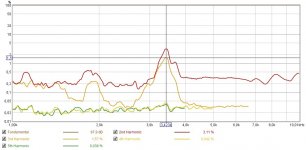

Cumulative spectral decay looks fine too, the ridges ar low in level and they are very dependent on the applied EQ, the high Q peaks/dips are very picky to it as we can see.
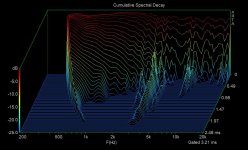
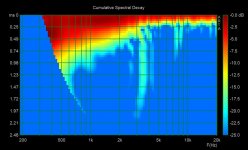
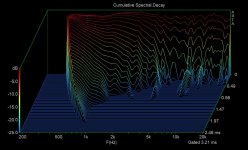
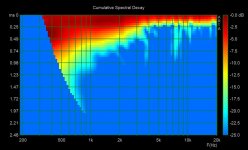
The sound coming from these tweeters (after EQ-ed) are really good, my only concern is the HD peak around 3,5kHz. Is this a bad thing? What can be done with that? The LT3 waveguide can help with that?
The drivers are came with individual factory frequency response measurements and the responses on the paper looks very different than what I measured (or can be seen in the first post here), there are no sign of bad things in the frequency response between 3-4kHz on the paper. Maybe they are measured with waveguide?
All measurements are done without waveguide, the tweeters are freestanding at the top of the speaker cabinets, crossover are acoustically LR4 at 2kHz, SPL approx 90dB/1m.
Harmonic distortion is really good, except the 2nd and 3rd harmonic peak between 3-4kHz:


Cumulative spectral decay looks fine too, the ridges ar low in level and they are very dependent on the applied EQ, the high Q peaks/dips are very picky to it as we can see.




The sound coming from these tweeters (after EQ-ed) are really good, my only concern is the HD peak around 3,5kHz. Is this a bad thing? What can be done with that? The LT3 waveguide can help with that?
The drivers are came with individual factory frequency response measurements and the responses on the paper looks very different than what I measured (or can be seen in the first post here), there are no sign of bad things in the frequency response between 3-4kHz on the paper. Maybe they are measured with waveguide?
Last edited:
Yes the factory measurement is with their waveguide.
Do you have your frequency response to share?
Free-standing tweeters are not great because there will be strong diffraction at the edges. Can you share a picture?
Maybe you can try to cut some cardboard to make a bigger baffle and see what change there is? Waveguides will help reduce diffraction but are also usually designed to be in a baffle. Some that are designed for free-standing will have a large rolled edge like this one.

Do you have your frequency response to share?
Free-standing tweeters are not great because there will be strong diffraction at the edges. Can you share a picture?
Maybe you can try to cut some cardboard to make a bigger baffle and see what change there is? Waveguides will help reduce diffraction but are also usually designed to be in a baffle. Some that are designed for free-standing will have a large rolled edge like this one.
Raw on-axis response of the 2 samples, and EQ-ed, crossed (at 2kHz LR4 to the 8" mid driver) horizontal 0-60 degree responses of 1 sample. Both measurements are done with freestanding on top of the cabinet (as on the picture below), time-gated at 3ms, unsmoothed. The EQ is just a quick attempt to get an approx flat on-axis response. Overall, the sound is very good imo, rich in detail, precise, holographic, detached from the speakers already.
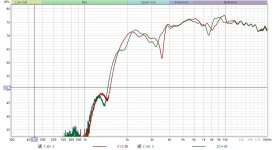
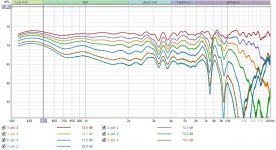
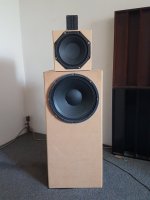



Last edited:
Well, maybe I will try a coax arrangement like that. Thanks the idea!
Anyway, I will try the LT3 waveguide too, but the shop sent me the LT6 wg instead the LT3.
Anyway, I will try the LT3 waveguide too, but the shop sent me the LT6 wg instead the LT3.
Last edited:
It might be interesting to use something like the BG neo 10 as a midrange. that would give you "planar sound" for most of your frequency range. It's large enough to mount something like this driver in front and not change the sound.Well, maybe I will try a coax arrangement like that. Thanks the idea!
Anyway, I will try the LT3 waveguide too, but the shop sent me the LT6 wg instead the LT3.
Today I created a 20x20cm baffle from cardboard for the tweeters. The dip around 3-4kHz got worse with this.
I'm still worrying about that dip, no other measurements showing this (other than the first post here by Tenson), nor the HD peak. BG Neo3 don't have that HD peak (full flat HD profile).
Okay, maybe the HD peak is the result of boosting the dip to get flat FR.
The factory on- and off-axis measurements are with the wg, but there is one without the wg, no dip around 3kHz.
If this driver have a dip like that, I call it faulty, but hoping the wg fixes it.
Why is so hard to get good measuring and good sounding driver? Okay I know, to buy a beryllium tweeter, for the price of a good used car... Radian have it too, for 800💲/piece.
Here is the factory on-axis response from the official website without the wg:
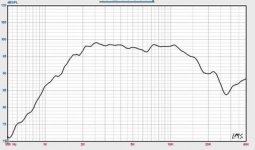
And here is the result of the 20x20cm baffle around the tweeter on top of the cabinet, blue is with tha baffle:
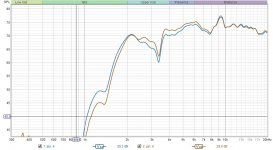
I'm still worrying about that dip, no other measurements showing this (other than the first post here by Tenson), nor the HD peak. BG Neo3 don't have that HD peak (full flat HD profile).
Okay, maybe the HD peak is the result of boosting the dip to get flat FR.
The factory on- and off-axis measurements are with the wg, but there is one without the wg, no dip around 3kHz.
If this driver have a dip like that, I call it faulty, but hoping the wg fixes it.
Why is so hard to get good measuring and good sounding driver? Okay I know, to buy a beryllium tweeter, for the price of a good used car... Radian have it too, for 800💲/piece.
Here is the factory on-axis response from the official website without the wg:

And here is the result of the 20x20cm baffle around the tweeter on top of the cabinet, blue is with tha baffle:

Last edited:
wow, that dip is pretty bad. I've had better luck using the GRS PT2522. It has a pretty smooth response from 2k up to 18k where it rolls off (100 +- 2db). I used the back cup version just to save myself from dealing with building a mini enclosure for the tweeter. It's also a good bit cheaper than the LT3 at $43 on parts express. I haven't heard the LT3 but it should have the same fast planar sound.
No teardown photos this time, but here are a few response plots of two Radian LT3 drivers I got. I've also attached the 3D model for the waveguide.
View attachment 1050378
View attachment 1050385
View attachment 1050379View attachment 1050381
I think these drivers internally must be very similar to the Neo3, only with bigger magnets and fewer but larger holes on the front. There is a striking similarity to the two dips in the response of Neo3 drivers at about 3KHz and 7KHz.
View attachment 1050384
Great jobNo teardown photos this time, but here are a few response plots of two Radian LT3 drivers I got. I've also attached the 3D model for the waveguide.
View attachment 1050378
View attachment 1050385
View attachment 1050379View attachment 1050381
I think these drivers internally must be very similar to the Neo3, only with bigger magnets and fewer but larger holes on the front. There is a striking similarity to the two dips in the response of Neo3 drivers at about 3KHz and 7KHz.
View attachment 1050384
Here is the factory measured data for one of my LT3 that I measured few posts earlier. Hoping the wavegide will do it's magic to give a similar response, but I have doubts that freaky 3kHz dip (see my measurements in post #30) would disappear. Shame that this factory measurement are 1/3 or 1/6 octave smoothed.
Tenson, do you have factory measurements paper for your samples?
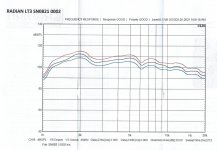
Tenson, do you have factory measurements paper for your samples?

Last edited:
I do have a response in the package. It looks similar to your one (sorry can't bother to find it).
I have not tested it without the rear chamber.
I have not tested it without the rear chamber.
I think sometimes I hear some strange things that are possibly not included in the sound material, maybe the resonance between 3-4kHz that is. Although is not very intrusive.And the distortion 'chimney' is indicative of some sort of rattle. Which might be much more audible than the objective figure seems to indicate.
I measured something similar in a Radian compression driver that also works with a circular diaphragm based on the same principle. They might not fully control this technology. I found it aggravating after a while. And the response of the manufacturer was quite remarkable. Fortunately I bought from TLHP and could return the drivers (concentric 6"). Otherwise, it would have been a costly affair. The cone section of the driver was even worse, with a Q above 1.
Last edited:
You meant concentric (coax) driver with planar tweeter?I measured something similar in a Radian compression driver that also works with a circular diaphragm based on the same principle...
...The cone section of the driver was even worse, with a Q above 1.
The cone section had a Qts above 1?
- Home
- Loudspeakers
- Planars & Exotics
- Radian LT3 Measurements